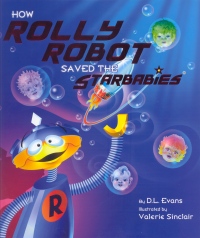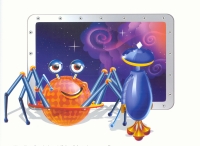| ________________
CM . . . . Volume XVIII Number 39 . . . . June 8, 2012

 |
How Rolly Robot Saved the Starbabies.
D. L. Evans. Illustrated by Valerie Sinclair.
Newcastle, ON: 1269895 Ontario Ltd. (Distributed by Fitzhenry & Whiteside), 2010.
48 pp. hardcover, $16.95.
ISBN 978-0-9867971-1-8.
Grades 1-3 / Ages 6-8.
Review by Leanne Ryrie.
*˝ / 4
|
| |
|

excerpt:
Rolly wasn’t supposed to have feelings.
He was a robot in a toy factory far away in outer space. There were many robots assembling toys; however, Rolly was different from all the others because he loved his job.
In D. L. Evans’ and Valerie Sinclair’s book, they tell a tale of a sensitive robot named Rolly who is misunderstood by his peers. He has slowly evolved so that he is able to do many jobs in his toy factory in Outer Space, and the robots around him resent the versatility he represents. As Rolly is shuffled from one area to another in the factory, he encounters a set of toys called Star Babies that have been kept a secret from the other robots. 
The problem presented in How Rolly Robot Saved the Star babies occurs when Rolly accidentally ends up on a spaceship. The spaceship encounters a storm, and the Captain inexplicably falls asleep. Rolly helps the Captain deliver the Star Babies to Earth. The book ends with Rolly staying with the Star Babies in the hopes that he will be appreciated as a toy by human children instead of being mocked by his robot peers in space.
Evans’ text has a number of different plot points that are, at times, difficult to follow. Rather than focussing on one lesson for readers, there are several lessons scattered throughout the text. The result is a confusing story that at times made little sense. Many of the pages had a great deal of text, and the entire story became significantly more complicated than necessary. I found that I had to read sections of the book several times in order to understand what was happening in the story.
The art work is bright and colourful, and the different robots are portrayed in interesting and imaginative ways. The art work supplemented the text and helped to clarify some of the aforementioned murky plot points. Sinclair’s art helps to keep the reader connected to the text and brings to life a part of the universe devoid of human life.
In preparing to review the book, I shared the story with a class of grade 2 students. The illustrations captivated the students, but, like the author of this review, the students had a number of questions about the plot of the book. As a group, we were eventually able to come to a consensus about what happened.
Not Recommended.
Leanne Ryrie teaches second grade in Winnipeg, MB.

To comment
on this title or this review, send mail to cm@umanitoba.ca.
Copyright © the Manitoba Library Association. Reproduction for personal
use is permitted only if this copyright notice is maintained. Any
other reproduction is prohibited without permission.
NEXT REVIEW |
TABLE OF CONTENTS FOR THIS ISSUE
- June 8, 2012.
AUTHORS |
TITLES |
MEDIA REVIEWS |
PROFILES |
BACK ISSUES |
SEARCH |
CMARCHIVE |
HOME |

